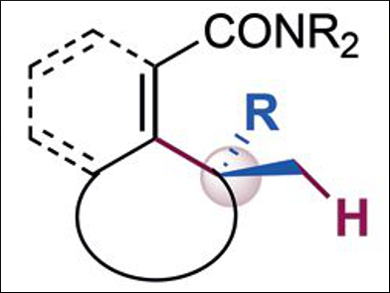The catalytic addition of a C(sp2)–H bond across the double bond of an alkene is a useful and atom-economical reaction. Research on this topic has been mainly focused on intermolecular couplings involving (hetero)aromatic precursors. Intramolecular examples are very limited. Moreover, these methods have been essentially limited to racemic reactions, and provide products with secondary or tertiary, but not quaternary stereocenters.
David F. Fernández, Moisés Gulías, José L. Mascareñas, and Fernando Lopez, Universidade de Santiago de Compostela, Spain, have developed an efficient intramolecular hydroalkenylation reaction that uses an iridium(I) bisphosphine catalyst to provide synthetically relevant cyclic products equipped with quaternary carbon centers (pictured). The catalyst system consists of Ir(cod)2BArF (cod = cyclooctadiene, BArF = tetrakis[3,5-bis(trifluoromethyl)phenyl]borate) and the electron deficient diphosphine ligand dFppe (dFppe = (C6F5)2P(CH2)2P(C6F5)2).
The method is not restricted to the C−H activation of alkenes and is also efficient for aromatic and heteroaromatic precursors. Several types of polycyclic scaffolds can be readily assembled. The team also gives preliminary results on an enantioselective variant, as well as examples for the manipulation of the products to give cyclic ketones with quaternary carbon centers. This enantioselective variant provides the highest enantiomeric ratios reported to date for a transition-metal-catalyzed hydroalkenylation process.
- Iridium(I)-Catalyzed Intramolecular Hydrocarbonation of Alkenes: Efficient Access to Cyclic Systems Bearing Quaternary Stereocenters,
David F. Fernández, Moisés Gulías, José L. Mascareñas, Fernando Lopez,
Angew. Chem. Int. Ed. 2017.
DOI: 10.1002/anie.201705105




